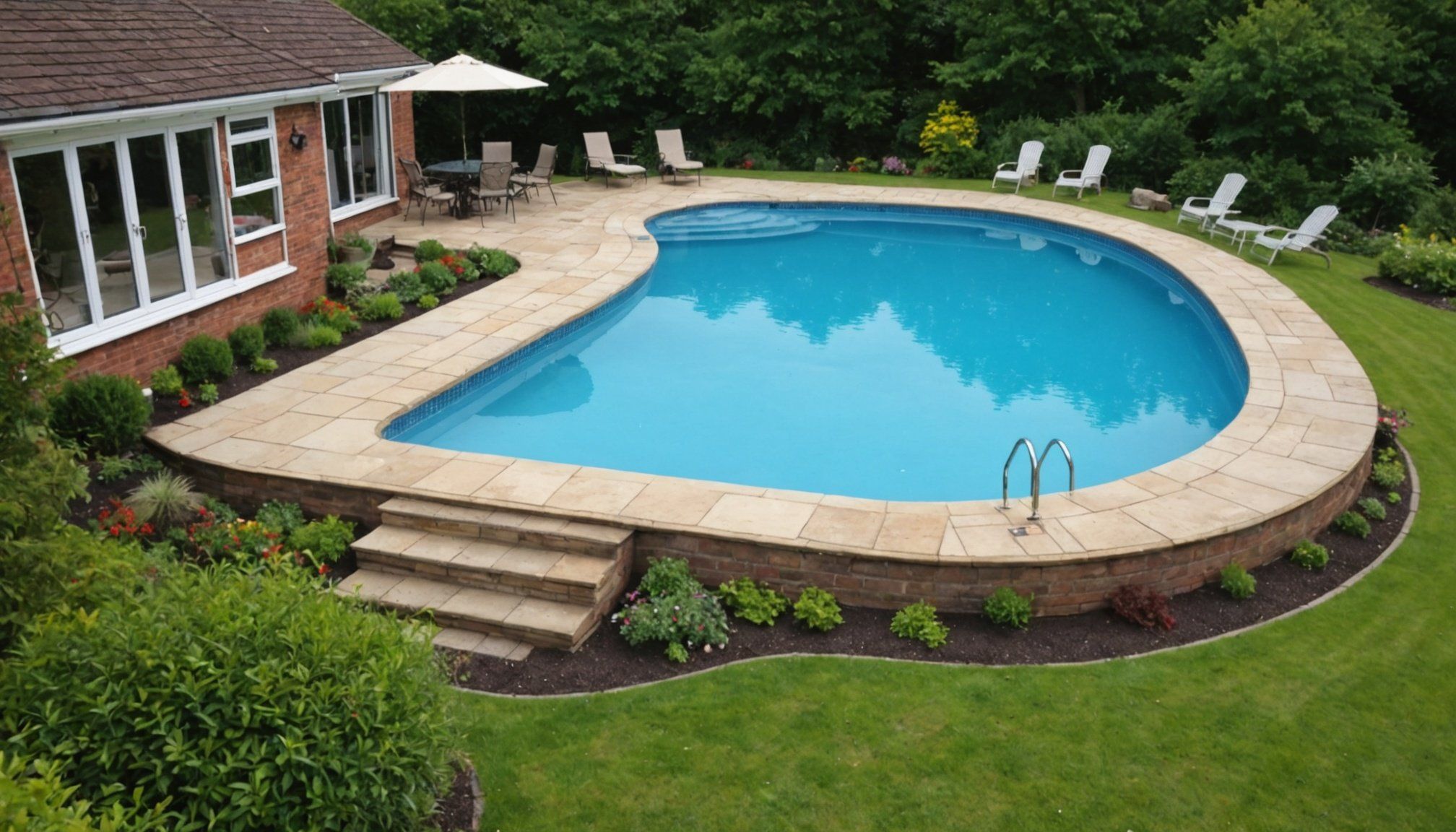Evaluating Your Pool’s Condition
Understanding the condition of your pool is crucial for maintaining its longevity and safety. The first step in a proper pool assessment is to examine visible signs of damage. Look for cracks in the pool’s surface, peeling or flaking finish, and loose tiles. These can be early indicators of more significant underlying issues.
Beyond the surface, assessing the structural integrity is essential. This includes checking the pool’s structural framework for any potential wear or deterioration. Evaluating the effectiveness of critical components like pumps, filters, and heating systems is also crucial to ensure they are functioning optimally. A failure in these systems can lead to more severe damage over time.
Have you seen this : Top Pool Care Blunders UK Homeowners Often Make and How to Avoid Them
Thorough inspections are vital. Regular, comprehensive checks can prevent small issues from metamorphosing into costly repairs. These inspections allow for the early detection of problems and can provide peace of mind. Additionally, understanding the condition of your pool aids in planning for any necessary maintenance or renovation efforts.
By taking a proactive approach with damage evaluation, homeowners can extend their pool’s life and enjoy a safe, pleasant swimming environment.
Also to see : Exploring the Benefits of Adding a Pool House to Your UK Swimming Pool Retreat
Essential Repairs and Maintenance
When it comes to maintaining your pool, addressing leaks and cracks is vital for preventing further damage. Small leaks can lead to significant water loss and structural issues. It’s crucial to regularly inspect your pool’s surfaces and edges for any signs of damage; if detected early, most leaks can be fixed with a simple sealant. Larger or persistent leaks, however, may require professional intervention to ensure a thorough repair.
Apart from cracks, ensuring the functionality of your pool equipment is part of essential repairs. This includes inspecting and servicing pumps, filters, and heaters. If any components are malfunctioning, repair or replace them promptly to maintain water quality and overall system efficiency.
Regular maintenance tips are key to extending your pool’s lifespan and can prevent costly repairs in the long run. Establishing a weekly routine of skimming debris, balancing water chemistry, and brushing pool surfaces can help mitigate common problems. Additionally, scheduling annual inspections by a professional can uncover minor issues before they escalate.
Engaging in these maintenance activities encourages peace of mind, knowing your pool is in excellent condition and ready for use whenever you are. Embracing these practices keeps repairs manageable and ensures your pool’s longevity.
Design Ideas to Enhance Your Pool Area
Transforming your pool area into a sanctuary of relaxation and aesthetics is achievable through thoughtful design ideas and enhancements.
Aesthetic Improvements
Creating a visually appealing pool area starts with choosing a theme or style that resonates with your personal taste. Consider incorporating stylish features such as decking made from natural wood or sleek, modern tiles. A well-chosen colour palette can bring life and harmony, tying together various elements around the pool design.
Lighting plays a crucial role in aesthetic enhancement. String lights, lanterns, or LED spotlights can subtly illuminate pathways and highlight unique design features, transforming the ambiance once the sun sets.
Functional Upgrades
Beyond beauty, consider functional improvements that enhance the utility of your pool area. Install shading options like umbrellas or pergolas to provide refuge from the sun. Adding comfortable seating such as lounge chairs or a cozy outdoor sofa invites prolonged enjoyment of your outdoor living space. For those seeking year-round outdoor living enhancements, heated pool features or a retractable enclosure can extend usage beyond the summer months.
Landscaping Ideas
Thoughtful landscaping can seamlessly integrate your pool into the surroundings. Planting trees for natural shade, adding colourful flowering plants, or sculpting hedges provides a lush and inviting atmosphere. Water features such as waterfalls or fountains add a soothing auditory experience, making your pool area feel like a hidden paradise.
Safety Considerations
Ensuring pool safety is crucial for creating a secure environment, particularly for families with children. One effective strategy is the implementation of safety barriers. These barriers should encompass fencing that fully encloses the pool area, featuring self-latching gates for controlled access. Incorporating pool covers is another essential safety measure, preventing accidental falls when the pool is not in use.
Understanding local regulations is imperative. In the UK, specific safety standards apply to pools, including recommended fencing heights and gate specifications. Adhering to these regulations not only ensures compliance but greatly enhances safety measures. The regulations are aimed at reducing the risk of accidental drowning and ensuring quick accessibility in emergencies.
To create a safe environment for families, consider installing pool alarms, which alert to any unexpected entries into the pool. Educating children about pool safety practices also contributes significantly to a safer pool area. Instill the importance of not running near the pool, and ensure children are always supervised when swimming. These combined efforts in implementing safety measures and following regulations foster a safe and enjoyable experience for everyone involved.
Cost Considerations and Budgeting
When considering pool renovation costs, it’s crucial to first estimate the potential expenses. This involves evaluating the scope of repairs, restoration needs, and possible design enhancements you wish to include. Basic repair costs might be lower, but if you’re planning for significant upgrades or changes in design, the budget will grow accordingly.
Effective budget planning includes researching the materials and labour required for your project. Prices can vary based on seasonal demands and regional differences. Planning during off-peak seasons might save some expenses.
Exploring financial considerations, such as financing options, is also important. Home improvement loans, refinancing, or personal savings can be viable methods to fund your renovation. Each option has its pros and cons, impacting your overall budget. For example, loans may offer immediate funds but can accumulate interest over time.
Consider consulting with financial advisors or pool renovation experts to ensure thorough and sensible budget planning. This proactive approach will help you avoid unexpected expenses and align your renovation project with your financial capabilities and goals. With a well-structured budget, the path to your dream pool becomes clearer and more achievable.
Professional Help vs. DIY
Choosing whether to hire professional services or embark on a DIY pool restoration project depends on various factors. Consider hiring professionals when facing complex damages, such as structural leaks or severe surface degradation. These experts bring experience and specialized equipment, ensuring thorough inspections and long-lasting repairs.
Professional services can sometimes be costly but provide peace of mind with their expertise. They often offer warranties, guaranteeing their work. To find trustworthy pool experts, check online reviews, ask for recommendations, and verify certifications. However, if you’re interested in savings and enjoy hands-on projects, a DIY approach might suit you.
DIY pool restoration is ideal for minor repairs, like patching small leaks or retiling areas. It allows homeowners to work at their own pace and within budget constraints. Before starting, gather expert advice through online tutorials or DIY guides. It’s crucial to understand the scope of work required, the tools needed, and potential pitfalls to avoid costly mistakes.
Ultimately, weighing the benefits and challenges can guide your decision. A combination of professional consultation and DIY efforts can lead to a rewarding restoration project, ensuring a safe and enjoyable pool environment.
Case Studies and Before/After Examples
Transforming an outdated pool into a modern oasis is no small task, but the results are often breathtaking. These pool transformations serve as a wealth of inspiration for homeowners eager to enhance their outdoor spaces. By examining successful case studies, we can uncover valuable insights and creative ideas.
Showcasing Successful Pool Renovations
Several homeowners have embarked on pool transformations that exhibit spectacular results. From installing energy-efficient systems to incorporating luxurious lounging areas, these projects highlight the potential major upgrades can achieve. A deep dive into these renovations reveals not only the aesthetic improvements but also the increased property value they bring.
Lessons Learned from Other Homeowners
When embarking on your pool renovation journey, consider the lessons learned from others. Common challenges include managing budget constraints and selecting materials that withstand both time and elements. Successfully navigating these issues results in incredible design outcomes and long-term satisfaction.
Visual Inspirations for Prospective Projects
Rich visual galleries from various case studies provide endless inspirational opportunities. Whether it’s converting a simple lap pool into a stunning infinity design or transforming a dated pool into a sleek minimalist retreat, these visuals fuel creativity. By mimicking or adapting elements that resonate with you, your pool can be the next remarkable transformation.
Assessing the Condition of the Swimming Pool
When embarking on a pool assessment, understanding common issues with neglected pools is crucial. Common problems include algae growth, water chemistry imbalance, cracked surfaces, and malfunctioning equipment. Addressing these issues early can prevent expensive repairs.
Conducting a condition analysis involves meticulous steps. Start with a visual inspection to note any visible damage like cracks or surface discoloration. Follow up with water quality tests to assess pH levels and chlorine concentration, as these are pivotal in maintaining a healthy pool environment. Checking for algae or unusual odours can further highlight water issues.
Next, a thorough damage inspection is essential. Examine the pool’s structural integrity by inspecting for leaks or subsidence signs. Look at the condition of tiles or liners, as deteriorations here often indicate underlying problems. Don’t forget to scrutinise connections, pipes, and the pool’s perimeter for signs of wear or corrosion.
Lastly, evaluating equipment functionality ensures the pool operates effectively. Check pumps, heaters, and filters to confirm they work seamlessly. Look for unusual noises, leaks, or reduced efficiency, which are signs of potential issues. Regular maintenance and prompt attention to repairs can significantly extend the lifespan of a swimming pool.
Creating a Revitalization Plan
Revitalizing a pool effectively requires a revitalization plan that combines vision and strategy. The first step involves setting clear goals for both the pool’s functionality and aesthetics. Consider what you want your pool to achieve—be it enhanced usability, energy efficiency, or a refreshed look that aligns with modern standards. This clarity will drive the subsequent stages of planning and execution.
Once the vision is established, budgeting forms the backbone of any successful restoration strategy. Determine the available funds and allocate them wisely across renovations and repairs. Keep in mind that prioritizing structural repairs is crucial to prevent future issues. A detailed budget not only ensures efficient spending but also avoids financial surprises.
Incorporating a project timeline with distinct milestones ensures the revitalization process remains on track. Break down the project into manageable phases, each with its timeline, to facilitate better coordination and resource allocation. Milestones act as checkpoints that help monitor progress, ensuring each phase aligns with the overarching revitalization plan.
Balancing these elements—clear goal-setting, prudent budgeting, and an organized timeline—forms a cohesive strategy, paving the way for a successful pool revitalization.
Step-by-Step Cleaning Process
Keeping a swimming pool sparkling clean involves a series of meticulous steps that ensure its longevity and usability. This guide provides essential maintenance tips and outlines the necessary cleaning equipment for optimal results.
Initial Debris Removal
Begin by skimming the pool’s surface to remove floating debris like leaves, insects, and twigs. A sturdy skimmer net attached to a telescopic pole will be invaluable. By tackling this chore first, you prevent clogging the filtration system, thereby prolonging its lifespan.
Water Treatment and Filtration
Maintaining water balance through proper chemical treatment is crucial. Test the water’s pH and chlorine levels using a reliable testing kit. Aim for a pH level between 7.2 and 7.6, and adjust accordingly using recommended chemicals. Once balanced, run the filtration system for at least eight hours a day to ensure water circulation and clarity.
Tile and Surface Cleaning
Periodic scrubbing of tiles and pool surfaces is essential to prevent the buildup of algae and calcium deposits. Equip yourself with a pool brush suited for your pool type to scrub walls. Using a waterline cleaning solution can keep tile surfaces shiny. Always adhere to safety precautions during cleaning, such as wearing gloves and goggles when handling cleaning agents.
Repairing Structural and Mechanical Issues
Pool repairs can be daunting, especially when confronted with persistent leaks and bothersome cracks. Identifying these repair needs early on is crucial to maintaining a well-functioning pool system. At times, issues like minor surface cracks can be addressed through DIY solutions with mechanical maintenance tools available at most hardware stores. However, when leaks remain elusive or cracks threaten the pool’s integrity, it might be prudent to seek professional help.
Professionals can accurately diagnose and implement comprehensive structural restoration processes to prolong the pool’s lifespan. While DIY repairs can save money, professional expertise ensures precision, preventing future complications.
To avoid frequent repairs, regular mechanical maintenance is essential. This includes checking pumps, filters, and heating systems to ensure they operate efficiently. Simple tips, such as ensuring the water chemistry is balanced and keeping debris out of the water, contribute significantly to preserving the pool’s condition.
Understanding when to tackle a problem yourself and when to rely on professionals not only aids in effective pool repairs but also ensures that maintenance is cost-effective in the long run. Keeping systems running smoothly with practiced routine checks is the cornerstone of pool preservation.
Design Ideas for a Modern Look
Creating a contemporary pool design requires a keen eye for detail and a passion for modern aesthetics. Current trends emphasize a minimalist approach, incorporating sleek lines and geometric shapes. Pools are often framed by infinity edges or custom cuts, enhancing visual appeal while ensuring functionality.
An essential aspect of achieving this look is the seamless integration of landscaping with pool features. Incorporate native plants and use natural stone or concrete to create a harmonious environment. This not only ensures a cohesive design but also promotes sustainability.
Furthermore, adding modern amenities can significantly elevate your pool. Consider installing LED lighting for dramatic nighttime illumination. Energy-efficient heating solutions, such as solar panels, ensure comfortable swimming temperatures without excessive energy costs.
Integration Considerations
When planning your pool design, think about how each element interacts within the space. Smart landscaping blends features like wooden decks or pergolas with the water area, creating an inviting, functional outdoor environment.
Keep in mind that incorporating technology, like automated cover systems, not only adds convenience but also aligns with modern expectations and enhances the practical use of the area. This approach ensures your pool is both a visual delight and a functional centerpiece.
Cost Considerations and Budgeting
Revitalizing a pool involves various expenses, making financial planning crucial. One must consider both visible and hidden pool renovation costs to manage a realistic budget. Typical costs often include resurfacing, which can range widely depending on material choice, and equipment upgrades such as pumps or filters. Labour charges for installation and repairs add another layer, often constituting a significant portion of the total expenditure.
Hidden costs, though less obvious, can considerably affect the budget, making budgeting tips essential. For instance, unforeseen structural repairs can unexpectedly arise during renovation. It’s wise to allocate a buffer for these unexpected expenses to avoid financial strain.
Exploring alternatives for financing larger projects is advisable. Home equity loans or dedicated pool loans can provide the necessary funds while distributing repayments over time. This approach not only eases immediate financial pressure but also enables more comprehensive renovations. Identifying potential savings is key, such as selecting less costly material options or taking advantage of off-peak pricing for labour and materials.
By being methodical in cost assessment and exploring various financing avenues, pool owners can ensure their renovation projects are both financially feasible and successful.
Understanding Safety Regulations
When it comes to pool safety regulations in the UK, compliance is essential to ensure the well-being of all users. The regulations focus on several key aspects that pool owners must adhere to.
Firstly, these guidelines emphasize the importance of safety barriers and signage. Barriers, such as fences around pools, are required to restrict unsupervised access, especially for children and pets. Signage must be clearly visible and provide warnings about potential hazards like deep water, slippery surfaces, or the absence of lifeguards.
Another crucial aspect is conducting regular safety inspections. These inspections help identify potential risks and enforce compliance with regulations. Compliance checks ensure that safety equipment is maintained and lifesaving gear is always available and in working order.
In addition to these measures, pool safety regulations also recommend training for staff members in emergency procedures and first aid. This preparation can be vital in preventing accidents and ensuring swift response in emergency situations.
By understanding and following these guidelines, pool owners can create a safe and secure environment for everyone. Compliance is not just a legal requirement but a commitment to safeguarding lives.
Finding Local Resources and Services
When embarking on pool renovations, selecting reliable contractors is crucial. Begin by exploring contractor directories to compare experiences, credentials, and ratings. A seasoned contractor not only assures quality but also saves money in the long run. Local community centers or forums often provide recommendations based on firsthand experiences, aiding in making informed decisions.
Aside from contractors, tapping into local resources for DIY supplies enhances your ability to handle minor repairs or enhancements independently. Known local hardware stores frequently offer workshops and can provide guidance on the best materials for your project. Utilizing these resources effectively can lead to cost savings and empower pool owners with flexible solutions.
Moreover, establishing a network of pool professionals is beneficial for ongoing maintenance and troubleshooting. Engaging with fellow pool owners or joining local pool service clubs can be invaluable. This network can introduce you to trusted pool specialists familiar with your locality’s issues, ensuring quick, competent assistance when required.
Lastly, remember to keep an eye out for community events or expos that showcase pool services. These events might offer opportunities to connect with vendors and professionals, enriching your renovation experience.
Seasonal Maintenance Tips
Taking care of your pool throughout the year ensures it remains in top condition, ready for use whenever the season calls for it. Here’s a closer look at seasonal pool care and a maintenance schedule that can help you stay on track.
Preparing the Pool for Winter and Reopening for Summer
Preparing your pool for winter, known as winterization, is crucial. Winterization involves lowering the water level, cleaning, adding winter chemicals, and covering the pool to protect it from harsh weather. This prevents damage and makes reopening for summer much smoother. When it’s time to reopen in summer, the process involves removing the cover, refilling the pool, and adjusting the chemistry levels. Regular maintenance throughout the summer keeps it inviting and safe.
Year-round Maintenance Best Practices
Regardless of the season, consistent checks are vital. Regular seasonal check-ups include balancing water chemistry, cleaning filters, and inspecting pool equipment. This practice ensures you catch problems early and maintain water quality.
Importance of Seasonal Check-ups and Upkeep
Seasonal check-ups guarantee your pool’s components function optimally. Routine care can prevent costly repairs, ensuring your pool is always in prime shape, whatever the season might be.











